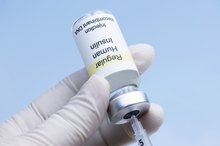About High Blood Sugar After Exercise
Exercise is a key component to managing diabetes. It helps you to shed extra pounds and lower your blood glucose level. Regular exercise will help you to avoid serious diabetic related complications. While exercise can make your blood sugar levels drop too low, it can also cause it to increase. Given this it is important to understand how your body responds to exercise by testing your blood glucose levels before, during and after exercise. This will help you learn how to eat and exercise at a level that works for you.
When you exercise, your body needs to provide energy to your cells. This energy comes from glucose that is in your bloodstream and stored in your body. To use the glucose, you need enough insulin. The American Diabetes Association states that in the case of type 2 diabetes, insulin is not available because the body does not produce enough or you are unable to use it properly. This can lead to complications when exercising if you do not take the proper precautions.
Considerations
In most cases, the reason your blood sugar levels rise too high after exercise is because they were too high before you started,according to the John Hopkins Diabetes Center. This is especially true if your pre-exercise reading is more than 250mg/dL. The center suggests taking two readings before you exercise. One reading should be 30 minutes before activity and the other right before you start. John Hopkins recommends that “A safe pre-workout blood glucose level is between 100mg/dL and 250mg/dL.” You should not exercise if your general reading is 300mg/dL or higher, your fasting reading is over 250mg/dL or if your urine test is positive for keytones--a byproduct of fat metabolism. The National Diabetes Information Clearinghouse states that if your level is just slightly high; light or low level activity may help to lower it. Your doctor will help you to set limits as to what level of exercise is safe.
- In most cases, the reason your blood sugar levels rise too high after exercise is because they were too high before you started,according to the John Hopkins Diabetes Center.
- This is especially true if your pre-exercise reading is more than 250mg/dL.
- The center suggests taking two readings before you exercise.
Identification
Normal Blood Sugar Range in Adults
Learn More
While regular, moderate exercise will help you to manage your diabetes, exercise that is too strenuous may be harmful. The John Hopkins Diabetes Center claims that “...very strenuous exercise can stimulate the liver to release extra glucose into the bloodstream, due to an increase in adrenaline.” When you exercise hard, your liver will try to make more glucose to help yo keep up. However, if your body can not use the glucose it will begin to accumulate in the bloodstream. The University of Wisconsin Health Center recommends that you should "exercise vigorously enough to increase your heart rate and breathing to sufficient levels, but not so hard as to cause exhaustion.” Working out at the right level will inhibit your body from releasing chemicals that interfere with glucose production and utilization.
- While regular, moderate exercise will help you to manage your diabetes, exercise that is too strenuous may be harmful.
- However, if your body can not use the glucose it will begin to accumulate in the bloodstream.
Warning
When you exercise, your muscles need more blood and oxygen to perform, in addition to the increased need for glucose. This means that the blood vessels that supply your muscles are stimulated to bring more blood and glucose to the area. According to the American Diabetes Association if you have type 2 diabetes, this process may not work correctly. The glucose may stay in your bloodstream rather then being delivered to the muscles. This can cause your blood sugar levels to rise quickly and too high. In a study by the ADA, this situation occurred most often in those who had blood vessel damage due to advanced or uncontrolled diabetes.
- When you exercise, your muscles need more blood and oxygen to perform, in addition to the increased need for glucose.
- The glucose may stay in your bloodstream rather then being delivered to the muscles.
Prevention/Solution
Creatine for Diabetics
Learn More
The Centers for Disease Control and Prevention suggest that if you have diabetes you should aim to exercise at a moderate intensity for 30 minutes on most days of the week. It is best to start off slowly and get some exercise each day. It states that “it’s better to walk 10 or 20 minutes each day than one hour once a week.” In addition, check your blood glucose levels frequently until you know how exercise affects you. Visit the CDC website for information on how to get started safely (see Resources).
- The Centers for Disease Control and Prevention suggest that if you have diabetes you should aim to exercise at a moderate intensity for 30 minutes on most days of the week.
Related Articles
References
- John Hopkins Diabetes Center: Diabetes and Exercise; Keeping Your Blood Glucose Levels in Check
- American Diabetes Association. 5. Lifestyle management: Standards of medical care in diabetes-2019. Diabetes Care. 2019;42(Suppl 1):S46-60. doi:10.2337/dc19-S005
- National Institute of Diabetes and Digestive and Kidney Diseases. Diabetes diet, eating, & physical activity. Published December 2016.
- American Diabetes Association. The big picture: Checking your blood glucose.
- American Diabetes Association. 6. Glycemic Targets: Standards of Medical Care in Diabetes-2020. Diabetes Care. 2020;43(Suppl 1):S66-S76. doi:10.2337/dc20-S006
- American Diabetes Association. 14. Management of diabetes in pregnancy: Standards of medical care in diabetes-2020. Diabetes Care. 2020;43(Suppl 1):S183-S192. doi:10.2337/dc20-S014
- Porcellati F, Lucidi P, Bolli GB, Fanelli CG. Thirty years of research on the dawn phenomenon: Lessons to optimize blood glucose control in diabetes. Diabetes Care. 2013;36(12):3860-2. doi:10.2337/dc13-2088
- American Diabetes Association. 5. Lifestyle management: Standards of medical care in diabetes-2019. Diabetes Care. 2019;42(Suppl 1):S46-60. doi:10.2337/dc19-S005
- Colberg SR, Sigal RJ, Yardley JE, et al. Physical activity/exercise and diabetes: A position statement of the American diabetes association. Diabetes Care. 2016;39(11):2065-2079. doi:10.2337/dc16-1728
- American Diabetes Association (ADA). Understanding A1C.
- Garber AJ, Abrahamson MJ, Barzilay JI, et al. Consensus statement by the American association of clinical endocrinologists and American college of endocrinology on the comprehensive type 2 diabetes management algorithm - 2019 executive summary. Endocr Pract. 2019;25(1):69-100. doi:10.4158/CS-2018-0535
Writer Bio
I hold a Master's degree in exercise physiology/health promotion. I am a certified fitness specialist through the American College of Spots Medicine and an IYT certified yoga teacher. I have over 25 years experience teaching classes to both general public and those with chronic illness. The above allows me to write directly to the reader based on personal experiences.









